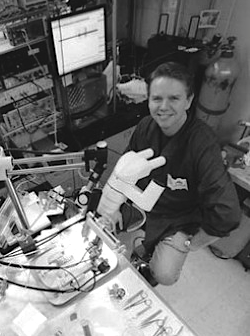Neuroscience Research
Drew Laboratory
 Mild hypothermia improves outcomes for patients resuscitated from cardiac arrest but
is difficult to implement in conscious stroke patients. We think this is due, in part,
to the difficulty of conscious patients.
Mild hypothermia improves outcomes for patients resuscitated from cardiac arrest but
is difficult to implement in conscious stroke patients. We think this is due, in part,
to the difficulty of conscious patients.
Research in the Drew lab is investigating and mimicking the mechanism rodents, such as rats and arctic ground squirrels, use to cool their bodies to near ambient temperature during the onset of hibernation.
They apply principle of central nervous system regulation of body temperature in hibernating species to induce therapeutic hypothermia in rats and test the efficacy of this approach to improve outcomes following a rodent model of stroke.
Taylor Laboratory
 Our research investigates mechanisms by which toxins and plant chemicals influence
neuronal function. We have two research programs:
Our research investigates mechanisms by which toxins and plant chemicals influence
neuronal function. We have two research programs:
- One investigates the influence of nicotine and alcohol on development, dysfunction and plasticity in breathing, which is controlled by neuronal networks of the vertebrate brainstem.
- A second program investigates the benefits of plant chemicals to the aging nervous system
Each research program addresses Alaska-relevant health issues, either SIDS (Sudden Infant Death Syndrome) or medicinal plants found in Alaska.
Each program also involves trainees that span the ranks from postdoctoral researchers to graduate, undergraduate and high-school students.
Breathing Lab (Vertebrates)
Harris Laboratory
 Sudden Infant Death Syndrome (SIDS) is a leading cause of infant mortality and is
a particular concern in Alaska, and for Alaska Natives. Currently there are no diagnostic
tests or therapies for SIDS.
Sudden Infant Death Syndrome (SIDS) is a leading cause of infant mortality and is
a particular concern in Alaska, and for Alaska Natives. Currently there are no diagnostic
tests or therapies for SIDS.
We think that dysfunctions in communication between cells in specific areas of the brain stem enhances infant vulnerability to SIDS.
Research in the Harris lab uses rodent models to investigate the consequences of specific brain stem dysfunctions on critical reflexes such as breathing and ways to modify these reflexes to overcome dysfunctions.
We hope to determine mechanisms causing vulnerability to SIDS, signs indication vulnerability that could become diagnostic tests, and therapies to reduce vulnerability and reduce the incidence of SIDS.
Edmonds Laboratory
 Defects in nicotinic receptor function underlie Alzheimer’s and Parkinson’s diseases,
autism, and nicotine addiction. We study compounds that modulate the functional properties
of these receptors. A detailed understanding of the actions of modulators of nicotinic
receptors will help us develop improved compounds that correct these defects.
Defects in nicotinic receptor function underlie Alzheimer’s and Parkinson’s diseases,
autism, and nicotine addiction. We study compounds that modulate the functional properties
of these receptors. A detailed understanding of the actions of modulators of nicotinic
receptors will help us develop improved compounds that correct these defects.
The development of effective, centrally acting drugs, including those that act at nicotinic receptors, has largely been limited to trial and error approaches. A major goal of our work is to characterize the relationship between the structure of a modulator (drug) and its functional properties to develop new strategies for development of improved clinically useful modulators of nicotinic receptors.
Through a collaboration with Dr. Edgar Buttner of the McClean Hospital at Harvard Medical School, we hope to better establish the role of nicotinic receptors in schizophrenia and to contribute t the development of better compounds for management of the disease.


